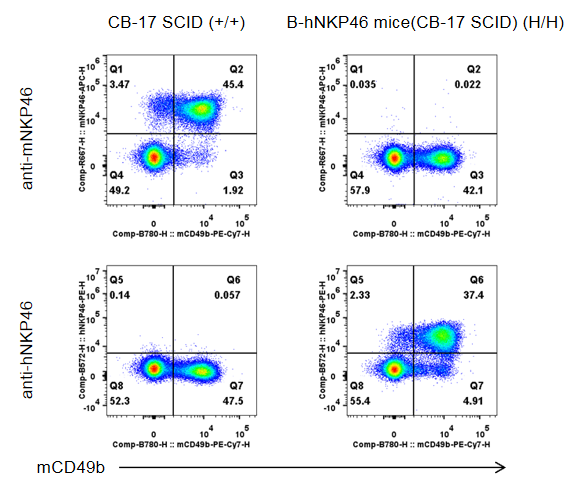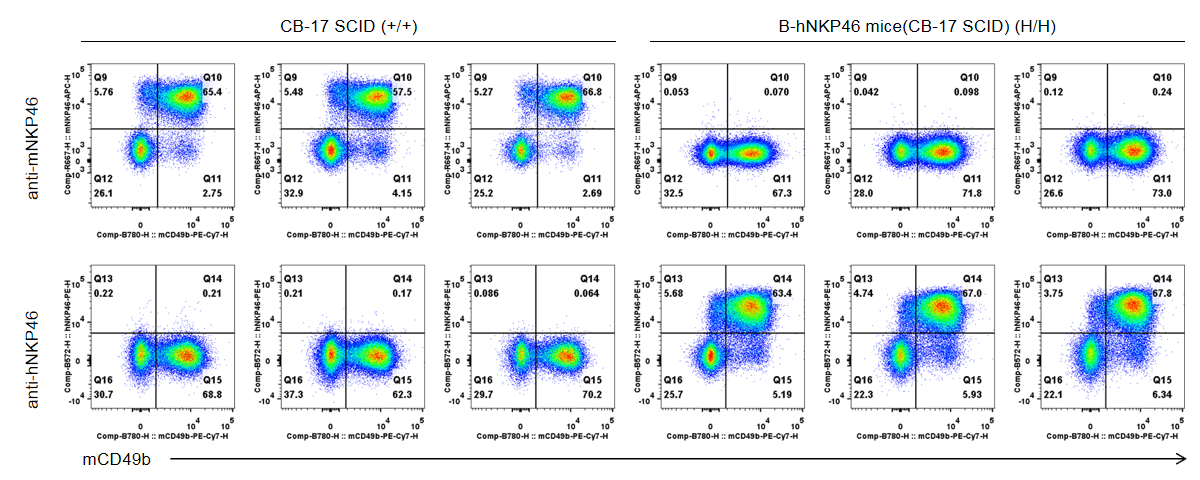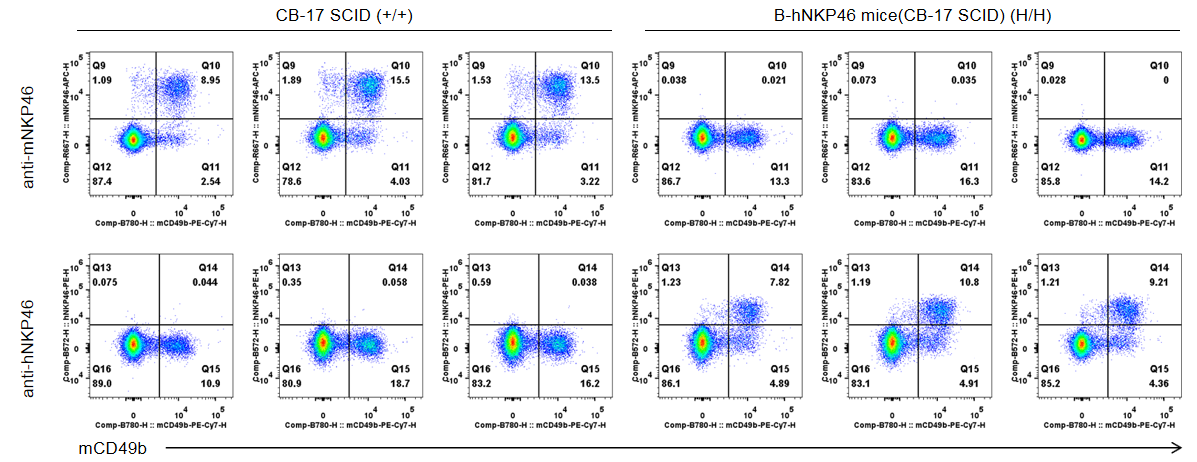|
Strain Name
|
CB17/lcr-PrkdcscidNcr1tm1(NCR1)Bcgen/Bcgen
|
Common Name
|
B-hNKP46 mice(CB-17 SCID)
|
|
Background
|
CB-17 SCID
|
Catalog number
|
112259
|
|
Aliases
|
CD335, LY94, NK-p46, NKP46
|
Protein expression analysis

Strain specific NKP46 expression analysis in wild-type and B-hNKP46 mice(CB-17 SCID) by flow cytometry. Splenocytes were collected from CB-17 SCID (+/+) and homozygous B-hNKP46 mice(CB-17 SCID) (H/H), and analyzed by flow cytometry with species-specific NKP46 antibody. Mouse NKP46 was detectable in wild-type mice. Human NKP46 was exclusively detectable in homozygous B-hNKP46 mice(CB-17 SCID).
Protein expression of NKP46 in spleen

Strain specific NKP46 expression analysis in wild-type and B-hNKP46 mice(CB-17 SCID) by flow cytometry. Splenocytes were collected from CB-17 SCID(+/+) and homozygous B-hNKP46 mice(CB-17 SCID)(H/H) (n=3, 6-week old), and analyzed by flow cytometry with species-specific NKP46 antibody. Mouse NKP46 was detectable in wild-type mice. Human NKP46 was exclusively detectable in homozygous B-hNKP46 mice(CB-17 SCID).
Protein expression of NKP46 in bone marrow

Strain specific NKP46 expression analysis in wild-type and B-hNKP46 mice(CB-17 SCID) by flow cytometry. Bone marrow were collected from CB-17 SCID(+/+) and homozygous B-hNKP46 mice(CB-17 SCID)(H/H) (n=3, 6-week old), and analyzed by flow cytometry with species-specific NKP46 antibody. Mouse NKP46 was detectable in wild-type mice. Human NKP46 was exclusively detectable in homozygous B-hNKP46 mice(CB-17 SCID).
Analysis of leukocytes cell subpopulation in spleen

Analysis of spleen leukocyte subpopulations by FACS. Splenocytes were isolated from female CB-17 SCID and B-hNKP46 mice(CB-17 SCID) (n=3, 6-week-old). Flow cytometry analysis of the splenocytes was performed to assess leukocyte subpopulations. A. Representative FACS plots. Single live cells were gated for the CD45+ population and used for further analysis as indicated here. B. Results of FACS analysis. Percent of T cells, B cells, NK cells, dendritic cells, granulocytes, monocytes and macrophages in homozygous B-hNKP46 mice(CB-17 SCID) were similar to those in the CB-17 SCID mice, demonstrating that NKP46 humanized does not change the overall development, differentiation or distribution of these cell types in spleen. Values are expressed as mean ± SD.
Analysis of leukocytes cell subpopulation in bone marrow

Analysis of spleen leukocyte subpopulations by FACS. Bone marrow cells were isolated from female CB-17 SCID and B-hNKP46 mice(CB-17 SCID) (n=3, 6-week-old). Flow cytometry analysis of the splenocytes was performed to assess leukocyte subpopulations. A. Representative FACS plots. Single live cells were gated for the CD45+ population and used for further analysis as indicated here. B. Results of FACS analysis. Percent of T cells, B cells, NK cells, dendritic cells, granulocytes, monocytes and macrophages in homozygous B-hNKP46 mice(CB-17 SCID) were similar to those in the CB-17 SCID mice, demonstrating that NKP46 humanized does not change the overall development, differentiation or distribution of these cell types in bone marrow. Values are expressed as mean ± SD.
Analysis of leukocytes cell subpopulation in blood

Analysis of spleen leukocyte subpopulations by FACS. Blood cells were isolated from female CB-17 SCID and B-hNKP46 mice(CB-17 SCID) (n=3, 6-week-old). Flow cytometry analysis of the splenocytes was performed to assess leukocyte subpopulations. A. Representative FACS plots. Single live cells were gated for the CD45+ population and used for further analysis as indicated here. B. Results of FACS analysis. Percent of T cells, B cells, NK cells, dendritic cells, granulocytes, monocytes and macrophages in homozygous B-hNKP46 mice(CB-17 SCID) were similar to those in the CB-17 SCID mice, demonstrating that NKP46 humanized does not change the overall development, differentiation or distribution of these cell types in blood. Values are expressed as mean ± SD.
Protein expression analysis via immunohistochemistry(IHC)

IHC of mouse ileum (upper panel) and spleen (bottom panel).
Image 2. Mouse ileum, huNKP46 IHC, approximately 200x. (2A) CB-17 SCID mouse. Labeling for huNKP46 is limited to nonspecific staining. The superficial epithelium of the mucosa (M) and smooth muscle of the tunica muscularis externa (TM) exhibit light nonspecific blushing. The submucosa (SM) is indicated. (2B) B-hNKP46 mice(CB-17 SCID). Small numbers of scattered round cells in the lamina propria (LP) exhibit moderate to strong membranous to cytoplasmic labeling (black arrows). There is light background nonspecific labeling similar to that in (2A). The mucosa (M), submucosa (SM), and tunica muscularis externa (TM) are indicated.
Image 4. Mouse spleen, huNKP46 IHC, approximately 200x. (4A) CB-17 SCID mouse. There is light nonspecific background labeling of erythrocytes/ serum in the red pulp. Red pulp (RP) is indicated. (4B) BhNKP46 mice(CB-17 SCID). Moderate to large numbers of scattered round cells exhibit moderate to strong membranous to cytoplasmic labeling (black arrows). Red pulp (RP) is indicated.
Note: This experiment was performed by the client using CB-17 SCID and B-hNKP46 mice(CB-17 SCID). All the other materials were provided by the client.
In vivo efficacy of anti-human NKP46-based Ab in B-hNKP46 mice(CB-17 SCID)
Antitumor activity of anti-human NKP46-based Ab in B-hNKP46 mice(CB-17 SCID). (A) Anti-human NKP46-based Ab inhibited BxPC-3 tumor growth in B-hNKP46 mice(CB-17 SCID). BxPC-3 cells (5E6) were subcutaneously implanted into B-hNKP46 mice(CB-17 SCID) (male, 7-8 week-old, n=4). Mice were grouped when tumor volume reached approximately 150-200 mm3, at which time they were treated with anti-human NKP46-based Ab with doses and schedules indicated in panel A. (B) Body weight changes during treatment. As shown in panel A, anti-human NKP46-based Ab was efficacious in controlling tumor growth in B-hNKP46 mice(CB-17 SCID). Values are expressed as mean ± SEM. (All antibodies were provided by the clients)
In vivo efficacy of anti-human NKP46-based Ab-individual tumor growth curves

Antitumor activity of anti-human NKP46-based Ab in B-hNKP46 mice(CB-17 SCID). (A) Anti-human NKP46-based Ab inhibited BxPC-3 tumor growth in B-hNKP46 mice(CB-17 SCID). BxPC-3 cells (provided by a client) (5E6) were subcutaneously implanted into B-hNKP46 mice(CB-17 SCID) (male, 7-8 week-old, n=4). Mice were grouped when tumor volume reached approximately 150-200 mm3, at which time they were treated with anti-human NKP46-based Ab with doses and schedules indicated in panel A. (B) Body weight changes during treatment. As shown in panel A, anti-human NKP46-based Ab was efficacious in controlling tumor growth in B-hNKP46 mice(CB-17 SCID). Values are expressed as mean ± SEM. Note:
Note: This experiment was performed by the client using B-hNKP46 mice(CB-17 SCID). All the other materials were provided by the client.
In vivo efficacy of anti-human NKP46-based Ab in B-hNKP46 mice(CB-17 SCID)
Antitumor activity of anti-human NKP46-based Ab in B-hNKP46 mice(CB-17 SCID). (A) Anti-human NKP46-based Ab inhibited BxPC-3 tumor growth in B-hNKP46 mice(CB-17 SCID). BxPC-3 cells (5E6) were subcutaneously implanted into B-hNKP46 mice(CB-17 SCID) (male, 7-8 week-old, n=6). Mice were grouped when tumor volume reached approximately 100-150 mm3, at which time they were treated with anti-human NKP46-based Ab with doses and schedules indicated in panel A. (B) Body weight changes during treatment. As shown in panel A, anti-human NKP46-based Ab was efficacious in controlling tumor growth in B-hNKP46 mice(CB-17 SCID). Values are expressed as mean ± SEM. (All antibodies were provided by the clients)
In vivo efficacy of anti-human NKP46-based Ab-individual tumor growth curves

Antitumor activity of anti-human NKP46-based Ab in B-hNKP46 mice(CB-17 SCID). (A) Anti-human NKP46-based Ab inhibited BxPC-3 tumor growth in B-hNKP46 mice(CB-17 SCID). BxPC-3 cells (provided by a client) (5E6) were subcutaneously implanted into B-hNKP46 mice(CB-17 SCID) (male, 7-8 week-old, n=4). Mice were grouped when tumor volume reached approximately 150-200 mm3, at which time they were treated with anti-human NKP46-based Ab with doses and schedules indicated in panel A. (B) Body weight changes during treatment. As shown in panel A, anti-human NKP46-based Ab was efficacious in controlling tumor growth in B-hNKP46 mice(CB-17 SCID). Values are expressed as mean ± SEM. Note:
Note: This experiment was performed by the client using B-hNKP46 mice(CB-17 SCID). All the other materials were provided by the client.
In vivo efficacy of anti-human NKP46 antibodies

Antitumor activity of anti-human NKP46 antibodies (provided by a client) in B-hNKP46 mice(CB-17 SCID). (A) Anti-human NKP46 antibodies inhibited NCI-N87 tumor growth in B-hNKP46 mice(CB-17 SCID). NCI-N87 cells (provided by a client) were subcutaneously implanted into homozygous B-hNKP46 mice(CB-17 SCID)(female, 7-week-old, n=7). Mice were grouped when tumor volume reached approximately 200-250 mm3, at which time they were intraperitoneally injected with anti-human NKP46 antibodies indicated in panel. (B) Body weight changes during treatment. As shown in panel A, anti-human NKP46 antibodies were efficacious in controlling tumor growth in B-hNKP46 mice(CB-17 SCID), demonstrating that the B-hNKP46 mice(CB-17 SCID) provide a powerful preclinical model for in vivo evaluation of anti-human NKP46 antibodies. Values are expressed as mean ± SEM. Significance was determined by two-way ANOVA test. *P < 0.05, **P < 0.01, ***P < 0.001. The overage of this tumor model is 43%.
Note: This experiment was performed by the client using B-hNKP46 mice(CB-17 SCID). All the other materials were provided by the client.
In vivo efficacy of anti-human NKP46-based Ab-individual tumor growth curves

Antitumor activity of anti-human NKP46 antibodies (provided by a client) in B-hNKP46 mice(CB-17 SCID). (A) Anti-human NKP46 antibodies inhibited NCI-N87 tumor growth in B-hNKP46 mice(CB-17 SCID). NCI-N87 cells (provided by a client) were subcutaneously implanted into homozygous B-hNKP46 mice(CB-17 SCID)(female, 7-week-old, n=7). Mice were grouped when tumor volume reached approximately 200-250 mm3, at which time they were intraperitoneally injected with anti-human NKP46 antibodies indicated in panel. (B) Body weight changes during treatment. As shown in panel A, anti-human NKP46 antibodies were efficacious in controlling tumor growth in B-hNKP46 mice(CB-17 SCID), demonstrating that the B-hNKP46 mice(CB-17 SCID) provide a powerful preclinical model for in vivo evaluation of anti-human NKP46 antibodies. Values are expressed as mean ± SEM. Significance was determined by two-way ANOVA test. *P < 0.05, **P < 0.01, ***P < 0.001. The overage of this tumor model is 43%.
Note: This experiment was performed by the client using B-hNKP46 mice(CB-17 SCID). All the other materials were provided by the client.
























